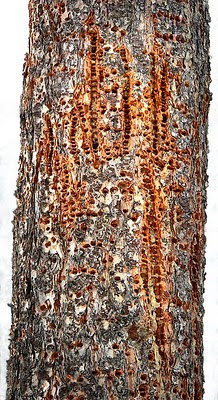If you don't like ants, you will love Williamson's Sapsuckers.
 Sapsuckers are an inconspicuous group of Robin-sized woodpeckers. They drill shallow holes into the bark of living trees, and the trees respond by filling the holes with clear, sticky sap. (Think of tapping a maple tree for syrup.) The sap is then eaten by these busy birds, along with an occassional insect or wild fruit. A feeding tree may have a few sap wells, or hundreds of sap wells. The holes are superficial and don't injure the tree unless they encircle the trunk or a limb.
Sapsuckers are an inconspicuous group of Robin-sized woodpeckers. They drill shallow holes into the bark of living trees, and the trees respond by filling the holes with clear, sticky sap. (Think of tapping a maple tree for syrup.) The sap is then eaten by these busy birds, along with an occassional insect or wild fruit. A feeding tree may have a few sap wells, or hundreds of sap wells. The holes are superficial and don't injure the tree unless they encircle the trunk or a limb. Most bird parents regurgitate food from their crops, but a crop full of ants probably isn't a good idea. So the Sapsuckers deliver beak-full after beak-full of wriggling black and red ants to their ravenous chicks, down inside the nest cavity. Apparently, ants are more nutritious and easier to carry than sticky sap.
Sapsucker chicks hatch out pink and featherless, but they'll be fully feathered within two weeks. After about a month, it's time for them to move out. The parents make fewer and fewer food deliveries to the nest. Instead, they'll land in nearby trees with a beak full of tasty treats, enticing the kids out into the big, wide world. When the young finally fledge, the parents will continue to feed them for a couple of days while the juveniles learn to forage for themselves.
 Williamson's Sapsuckers are also different from the other woodpeckers in that they are strongly sexually dimorphic -- the males and females look very different from each other. In most woodpecker species, the males and females only differ slightly in the amount of red feathering, with the males having slightly more color.
Williamson's Sapsuckers are also different from the other woodpeckers in that they are strongly sexually dimorphic -- the males and females look very different from each other. In most woodpecker species, the males and females only differ slightly in the amount of red feathering, with the males having slightly more color. With the Williamson's, the female is mostly marbled brown with a yellowish belly. The male is mostly black, with a yellow belly and a touch of red on the throat. They look so different from each other that they were thought to be two different species until 1873. The top photo shows the female delivering ants to the nest, the middle one shows their main feeding tree, and the bottom image shows the male.
Behind the lens: Photographed with a Nikon D700, 500mm f4 lens, 1.6X teleconverter, and a really good tripod. If you can just sit still, most birds will tend to ignore you.


